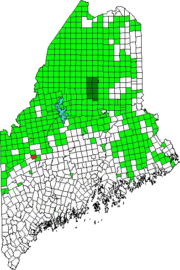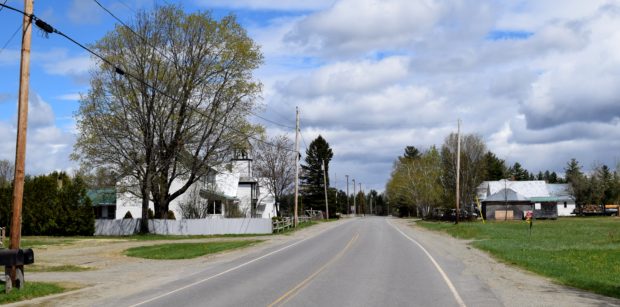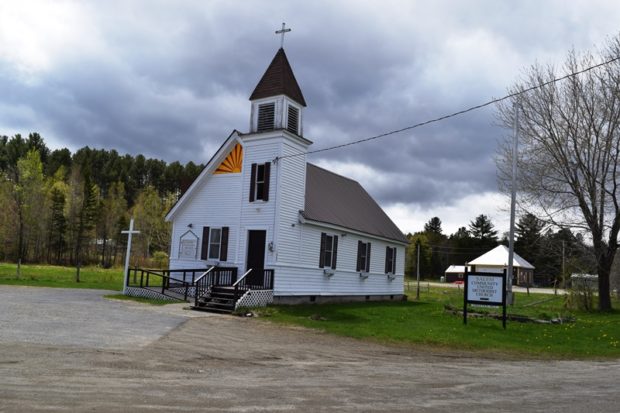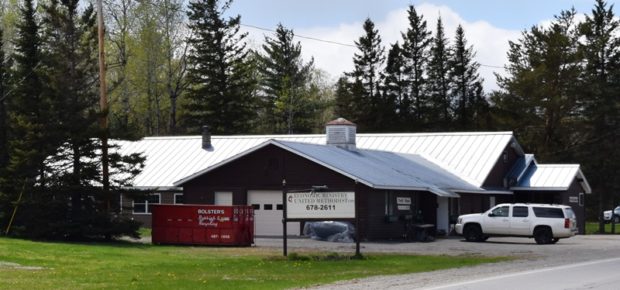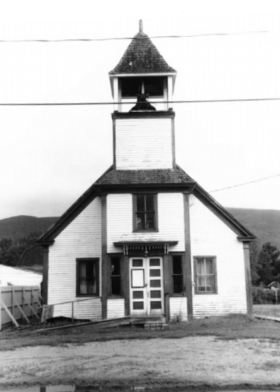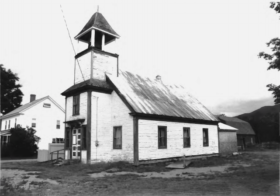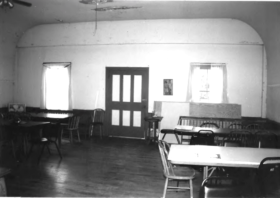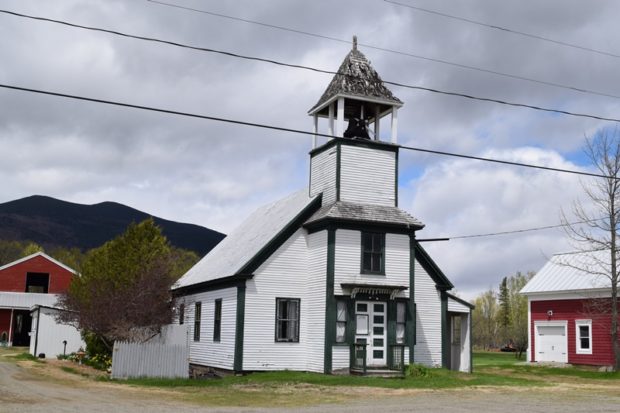
Salem, in Franklin County, was first settled by Benjamin Heath, who cleared land in what was then a portion of Phillips, Maine in 1814. The following year, Heath returned with two other men, who cleared additional lots, and permanently settled with their families in 1816. By 1821 twenty-four families had settled in the area, and the residents submitted a petition to the Maine legislature to incorporate the Town of North Salem. The new town was to consist of land claimed by the towns of Phillips and Freeman, which opposed the alteration of their boundaries. The residents persisted, and in 1823 were granted a charter to incorporate as the North Salem, formed by segments of the above mentioned towns and 3200 acres from Mount Abram township. In 1834 the “North” was dropped from the town’s name.
Throughout most of the 19th century, farming and logging were the most important industries. Both supplied a string of saw and grist mills, and a starch mill. The town was never large enough to support more than one or two stores at a time. The population had peaked in 1840 with 561 residents. In 1870 the town had a population of 370 and in 1886 supported four schools. By the turn of the 20th century prosperity began to wane and town officials were lamenting that many farms had been abandoned, their fields covered in brush.
Salem has always been a remote village, accessible on Route 142 between Phillips and Kingfield. Partially destroyed and rebuilt after a flood in 1855, the Patterson Mill complex, which included a cooper shop, saw mill and grist mill, remained in business until 1868, after which the starch factory closed. In 1883-84 the town received a slight economic boost with the arrival of the Franklin and Meganic Railroad. This narrow gauge line ran between Strong and Kingfield. Although it passed through Salem it mostly serviced logging camps. The opportunities provided by this line did not stem the population decline, which continued into the 20th century.
The 1969 Mt. Abram High School, in Maine School Administrative District #58, is located in Salem Township, and serves the towns of Avon, Kingfield, Phillips, Strong, and Salem Township. Students in Eustis and Stratton have the option to attend Mt Abram as well.
The town started planning for a Town House in 1857. As a requirement of incorporation, a town had to set aside a certain amount of land for the town’s first settled minister and church. In Salem the Ministry Fund was divided on the basis of the number of adherents to denominations, which included Adventists, Methodists, Free Will Baptists and Universalists in the 19th century.
Meetings were held in houses and schools, eventually in the town house. The use of the Town House for religious services rotated through the various faith organizations, based on which were served by ministers.
Salem Evangelical Church (now Methodist) was built in 1901 on the west side of the River. While this
remains the only dedicated religious building in town, the Town House still hosts weddings and funerals.
The “Economic Ministry” of United Methodists near the church “seeks to promote social justice and provide material, educational, and spiritual support as first steps toward self-sufficiency in this region of severe economic challenge.”*
By 1940 the population had shrunk to 78. The residents agreed on March 30, 1945 to give up the town charter to the State and to become an unorganized territory. As a result, all financial and governmental decisions were placed in the hands of County or State officials. The Town Records were relocated to the Maine State Archives, the post office discontinued, and all town owned property sold. The Town House and the Mt. Abram Cemetery were sold to the newly established Mount Abram Cemetery Association. The building was renamed “Salem Community House.” Since then the remaining population have maintained it to provide the community with a public building for social, educational and voluntary events. As the last tangible link to the Town of Salem, the (Former) Town House hold a key position in maintaining this communities’ historical identity.
National Register of Historic Places – Listings
Salem Town House (former)
The Salem Town House is the only historic public building in Salem Township. It was built in 1858 by the residents of Salem for use as a polling place, town meeting site, and the location of all governmental activities. By default, as the only large gathering facility in the town until 1901, it also provided space for religious services, weddings, funerals, and meetings of social and voluntary clubs.
Architecturally, the building is notable for its two stage bell tower, and compact scale. It is often assumed to be a church, since its configuration resembles a common religious structure rather than the more formal civic buildings that generally characterize Maine’s mid-19th century town houses.
The building served the Town of Salem until the municipality’s charter was forfeited to the State of Maine in 1948, and the town became an unorganized territory. At that time it was renamed the Salem Community Building, and continues to actively provide the community with meeting and performance space. Importantly, this building is the only existing local reminder of the community’s existence as the Town of Salem between 1823 and 1945.** [B&W photos by Christi Mitchell, 2004]
Additional resources
* “United Methodist Economic Ministry.” https://www.facebook.com/umeconomicministry/ (accessed May 26, 2019)
Salem Town House (former) and Township history,
Text: https://npgallery.nps.gov/pdfhost/docs/nrhp/text/05000795.PDF
Photos: https://npgallery.nps.gov/pdfhost/docs/nrhp/photos/05000795.PDF
** From Maine Historic Preservation Commission:
“An Act to Provide for the Surrender by the Town of Salem of Its Organization” in Acts and Resolves passed by the 91 st and 92nd Legislatures of the State of Maine. P. & S. L, 1945, ch. 4. (Augusta, Maine: Kennebec Journal Publishing), 1945.
Decker, Les. “A History of Salem Church’s” (sic). Manuscript essay, n.d. Copy on file at the Maine Historic Preservation Commission, Augusta, Maine.
Deeds, various years. Franklin County Register of Deeds, Franklin County Courthouse, Farmington, Maine.
“
Lindsell, Robert M. The Rail Lines of Northern New England. (Pepperell, Massachusetts: Branch Line Press), 2000.
Maine Register. State Year-Book and Legislative Manual. (Portland, Maine: Greenville M. Donham), various years, 1871 -1905.
Mills, George W., Nelson P. Harris, Walter S. Lovejoy, Edgar Wills, and Walter S. Heath. Our First Old Home Day at Salem. Maine. August Seventeenth. 1904. (Boston: Heath and Company), 1905.
Mosher, John P. and Leon Cranmer. “Report of Phase I and Phase II Survey of the Salem Bridge Replacement Project (PIN 8973.00), Salem Township, Maine.” Maine Historic Preservation Commission, March 2002.
Thompson, George A. and F. Janet Thompson. A Genealogical History of Freeman. Maine 1796-1938. (Bowie, MD: Heritage Books, Inc.), 1996.
Town of Salem Town Records, 1823 -1866. Original records located at the Maine State Archives, Augusta, Maine.
Varney, George. J. A Gazetteer of the State of Maine. (Boston: B.B. Russell), 1882.
United States Decennial Population Census, 1790 -1930. Somerset and Franklin County, Maine. Copies on microfilm, Maine State Archives, Augusta, Maine.


